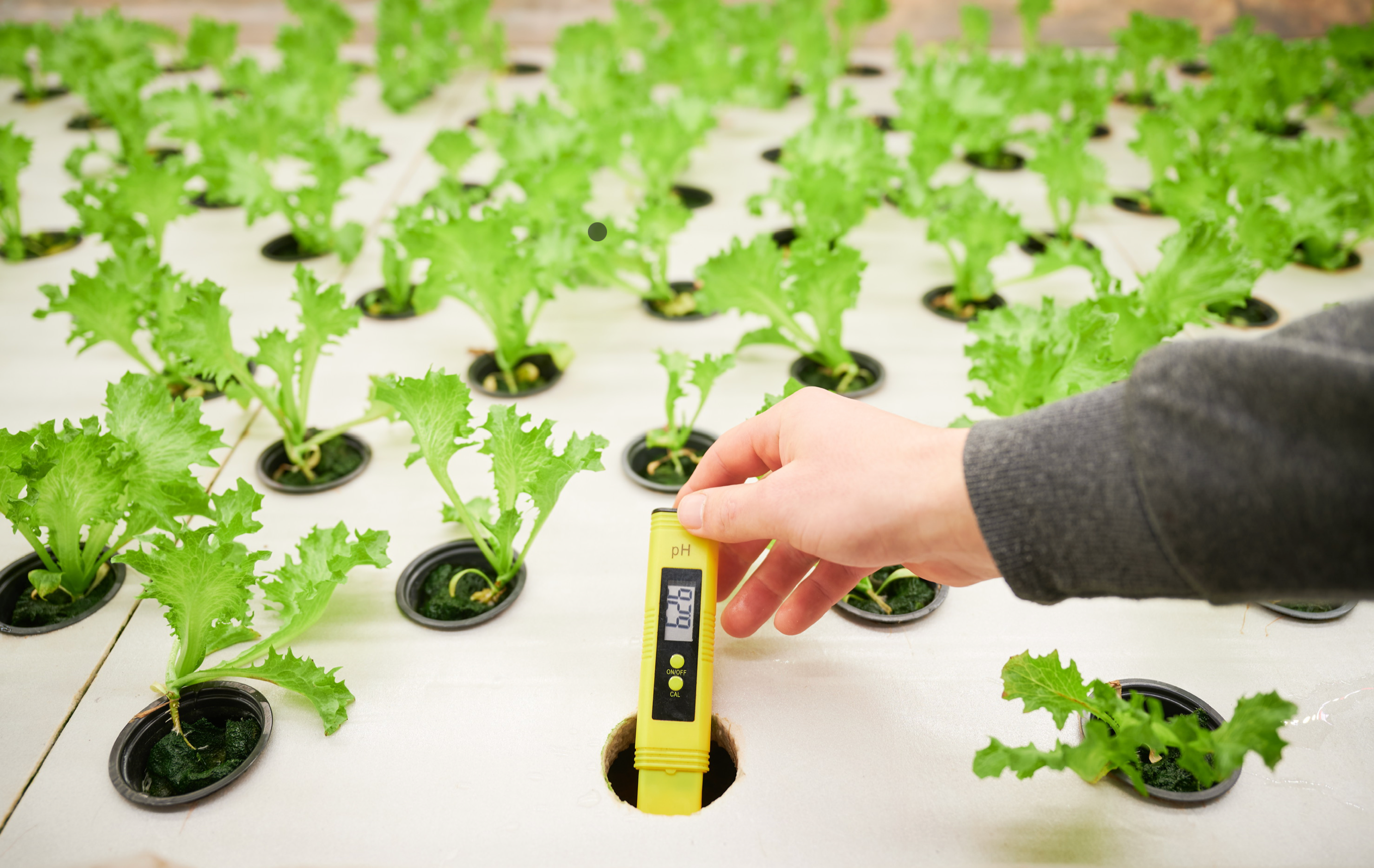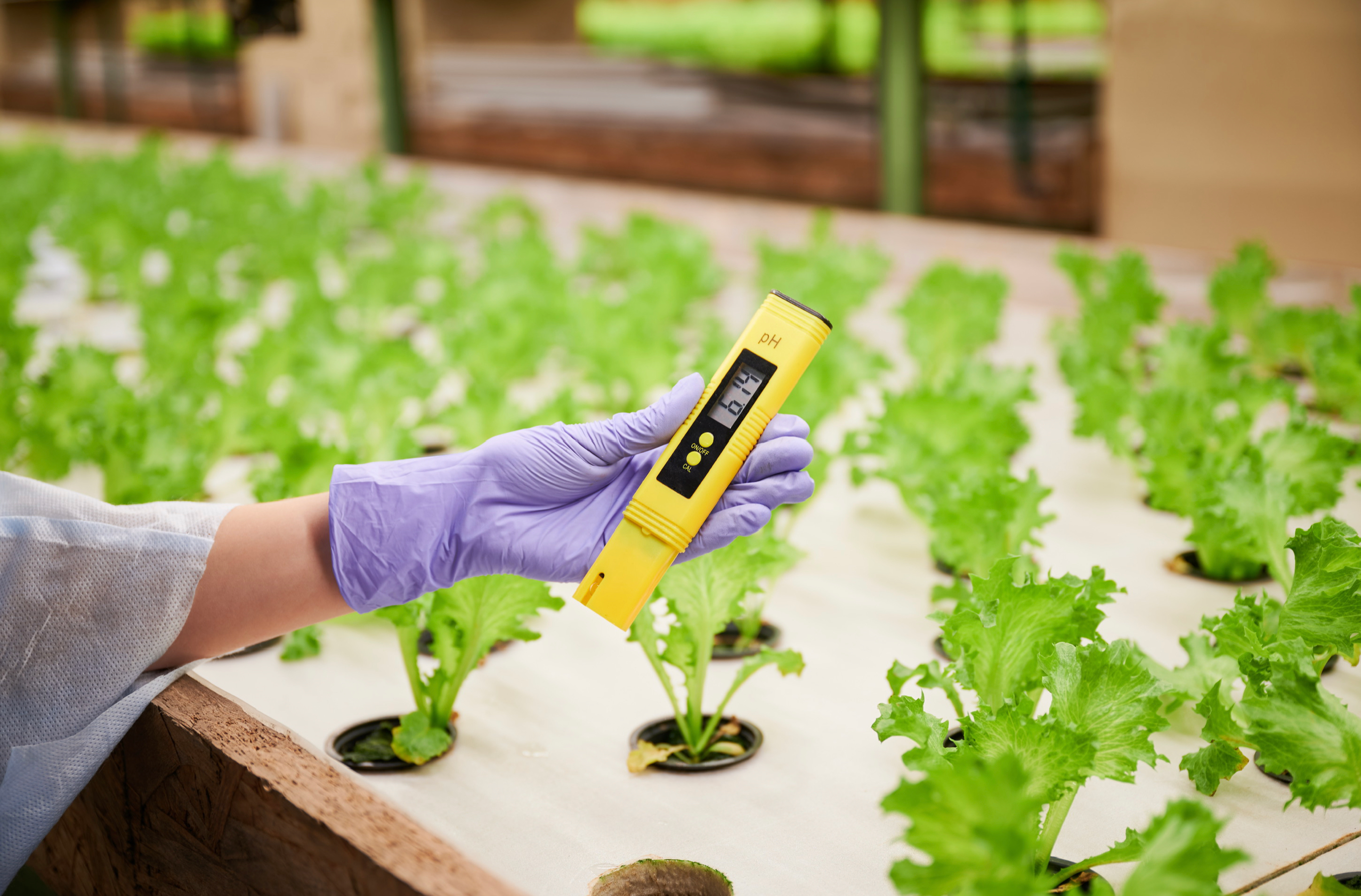Hydroponic Systems for Beginners

Three Simple Hydroponic Systems for Beginners Explained
If you’re just starting out with hydroponics and looking for easy hydroponic systems for beginners, you’ve come to the right place! In this article, we’ll cover hydroponic systems that are beginner friendly and are easy to set up and run. If you’re a beginner to hydroponics, these systems are great to start out with and learn the ropes of hydroponics. We’ll cover Kratky systems, Deep Water Culture (DWC) systems, and Wick systems. You will learn how all these hydroponic systems work and how to build them. Once you’ve spent some time with one of these systems, you can move on to more complicated systems, like Drip, Ebb and Flow, Nutrient Film Technique (NFT), or even Aeroponic systems.
The Kratky Method
Kratky systems are very easy to establish and maintain. They are one of the simplest forms of hydroponics. It’s a good method for growing individual plants, but not suitable if you want a hydroponic garden that includes a wide range of plants. You don’t need pumps for this method to work. This can be a nice method if you want to give hydroponic gardening a go and just want to start with one or two plants. It would allow you to make a judgement call after this as to whether you would like to expand your hydroponic garden to something more diverse using a different method and whether you have the time available to do so.
Some of the advantages of the Kratky Method are that it’s very simple, it’s inexpensive, and there are very few parts to it. It’s not complex, and it’s very simple to maintain. While the simplicity of the system is appealing in that it doesn’t take much to set up, doesn’t cost a lot, and it’s not difficult to maintain because there are no mechanical parts, such as a water pump, this can limit the control you have over feeding your plants. It can sometimes be difficult to top up the nutrients accordingly, and no oxygen is getting to the roots. This is a good method to try out hydroponics, and it’s great for children to have a go. If you simply wish to grow a decorative plant—it’s fine, but this isn’t a technique to provide you with regular food to help you live a sustainable lifestyle.
Sometimes plants can get root rot in this system if there isn’t much of a gap between the roots and the plant above the surface. If this system doesn’t seem quite right for you, then you can consider a Deep Water Culture (DWC) system instead, which will be covered later in the article.

Building a Kratky System
A Kratky system is essentially a DWC system without a pump. It is perhaps one of the easiest systems to build and maintain, as it doesn’t require any electronic devices and electricity to run.
In a Kratky system, nutrients are added to the reservoir. Plants with the growing mediums are placed into net pots which are held by a lid and hung above water. Plants’ roots are submerged into the water and partly exposed to the air so that they can get both nutrients from the solution and oxygen from the air.
Plants will absorb water and the water level will decline, leaving a gap and exposing the roots to air. Kratky systems are good for growing leafy greens, lettuce, and herbs. They usually grow quite fast, so when the water in the system is almost empty, plants typically reach their harvest time. If the plants haven’t quite reached their harvest time or you want to continue growing, you can add more water and nutrient solution and adjust pH level accordingly.
To build a Kratky system, you will need:
- A reservoir: The size depends on how large the plants you want to grow are and how big you want your system to be. A large 2-liter soda bottle or a milk jug can work if you want to grow small plants or herbs. I typically use a 5-gallon (19L) black bucket.
- A lid: Either plastic or even a Styrofoam one works. The lid is very important as this is what holds your plants and keeps the water in the system from evaporating. It’s good if your reservoir already has a lid. If you’re going to use a bucket, many of them are sold with lids. But if your reservoir doesn’t have one, you’ll need to get one.
- Net pots: Choose the size according to the size of your plants. We usually use 3-inch net pots, and they work great for most plants.
- Growing medium: Hydroton is preferable as it is easy to work with, pH neutral, and has good aeration.
- Nutrient solution
- pH measurement tools to check the pH level of your system
- pH control kit: You might need it to adjust the pH level of your system if it’s too low or too high.
Instructions
- Drill or cut holes in the lid large enough to place and hold a net pot.
- Fill the reservoir with water—distilled or filtered water is preferred.
- Add the nutrients at suggested amounts and stir the nutrient solution so that everything is mixed properly.
- Check the pH level of your solution. If it is between 5.5 and 6.5—that’s great.
- Adjust the pH level with the pH kit if it’s outside the recommended range.
- Place the net pots with the growing medium and plants into the holes in the lid. Make sure the plants’ roots are partly submerged and partly exposed to air.
Deep Water Culture (DWC) Systems
A DWC system puts the roots of your plants into the nutrient solution. You will need to put oxygen into the water in order for plants to survive, so will need to use something like a diffuser or an air stone for a DWC system to ensure that the solution is aerated. Any plants you place in the solution should use net pots to keep them in place. Usually, these plants are placed in a foam board or in the top of the container that you’re using as a reservoir. Plants will easily be able to absorb the nutrients because their roots are directly in the solution, and this means they should grow quickly. The key thing to look out for and be aware of is root rot. You’ll need to ensure that your roots are kept clean and healthy.
DWC hydroponics is low maintenance once the initial set up has been done. You will need to replace the nutrient solution every 2–3 weeks and ensure the pump works properly at all times in order to provide oxygen to the air stone. It is possible to make DWC systems inexpensively at home, and you can pick up a pump and an air stone cheaply from a garden center or a pet store. This type of hydroponic system is good for growing herbs, lettuce, and leafy greens, but it would struggle with larger slow-growing plants or anything that flowers. You can grow tomatoes and peppers in a DWC system with a bit of work.
You can use an old aquarium and Styrofoam for this and use that as a “lettuce raft”. This type of system doesn’t take a lot of space, and generally it will yield more successful results than the Kratky method. It’s better than the Kratky Method because it uses an air pump, which helps provide more oxygen to the plants’ roots, but it’s still simple and doesn’t have a lot of mechanical parts.
In a DWC system, the water does stay still a lot, and this can cause bacteria, algae, fungi, and mold to grow, which is bad news. While an air pump can give some aeration, depending on how many plants you have in your tank, whichever plants are nearest to the air stone will take most of the oxygen. The best place to place an air stone is in the middle of the tank to try to be fair, but the plants on the edge might not get their fair share of oxygen.
Deep Water Culture systems don’t work with vertical gardens or hydroponic towers, so they’re not really designed to fit in a small space or to make the best use of the space you have available. DWC systems are also more difficult to clean because you would need to remove all the plants to empty the tank and get rid of any algae, so you would typically do this when you’re not using the tank at all or when you’re changing over crops.

Building a DWC system
For a Deep Water Culture system, the general rule of thumb is to get the best equipment you can afford to because it will help your hydroponic system to thrive in the long run.
You will need:
- A sturdy plastic tote box with a lid (7 gallons or 26.6L in volume), ideally a black tote with a yellow lid, but this isn’t strictly necessary. The size will depend on how many plants you want to grow.
- 3 or 4-inch net pots, ideally with a lip (cheaper versions don’t have a lip, but they easily fall through, it is worth getting ones with a lip, even if they’re a bit more expensive).
- Drill hole saw kit and drill bit
- Growing medium: Hydroton clay pebbles work great in DWC systems.
- Nutrient solution
- pH measurement tools to check the pH level of your system
- pH control kit: You might need it to adjust the pH level of your system if it’s too low or too high.
- Aquarium air pump: If you’re on a budget, then get what you can, but the smallest and cheapest isn’t always the best buy because you want the most air bubbles you can possibly get to oxygenate your plants well and make them thrive.
- Air hose: It needs to be flexible, and ideally, it should be opaque.
- Check valve to prevent water from entering the air hose or pump when the power is off.
- Air stone: Again, this will depend on your budget, but small and cheap air stones aren’t as effective. Try to get the largest air stone you can that fits in your reservoir space to produce the most bubbles you can for healthy plants.
Instructions
- Plan where you want your net pots to go, set them out on the tote lid, and mark the spots. Then use a hole saw to cut the holes.
- Put the net pots through the holes and ensure the holes aren’t too big so that they do not fall through. Having quality net pots with the lip will help here.
- Next, drill a hole in the tote lid to put the air hose through.
- Ensure the air hose can go from the middle of the reservoir to your pump (approx. 3 feet or more, depending on where you have things situated). Connect your air stone to the end of the air hose and put the other end of the air hose through the tote lid and connect it to a check valve. Check that this allows air flow. Connect the other end of the check valve to the air pump.
- Put the nutrient solution into the reservoir, ensuring that it covers the bottom of your plants’ roots. A top tip is to mark the tote with a water level mark so that you don’t have to measure this when you come to change the water—you just know where you should fill it up to.
- After adding the nutrient solution, check the pH level after 15 minutes. It should be between 5.5 and 6.5. If it’s outside the recommended range, adjust it accordingly.
- Add your plants—you can put hydroton into the net pots, put the plants in, then put more hydroton around the plants until it’s up to the top of the net pot.
If you don’t wish to use a tote box, you could use a 3.5-gallon (13l) bucket, a 10-inch net pot, an air pump, air tubing, an air stone, rockwool, and expanding clay growing medium. You can buy these items from a garden center, a hydroponic store, or online. You would fill the reservoir with nutrient solution, connect the air stone to the air pump and put that in the bucket, put the plant into rockwool, have the roots in the reservoir, and put clay growing medium around the top of the plant, and switch on the air pump to give the plant lots of oxygen. If you decide to build your own DWC system like this, it’s a good idea to take your plants out of the bucket every 2–3 weeks and replace the nutrient solution, then put the plants back in. You can add as many buckets and plants to your DWC system as you want.
A very inexpensive way of building a DWC system is making use of pre-existing resources that you have to hand. You could use a clean bucket or an old aquarium to hold the solution in, place Styrofoam on top, and put the net pots in it. It is important to ensure that only the roots are submerged in the solution and no other part of the stem or vegetation. It is OK for 1.5 inches of the roots to be above the waterline because the air stone bubbles will pop up and splash the exposed roots, so they do not dry out.
Wick Systems
Wick systems are typically considered to be one of the easiest types of hydroponic systems, and most people can grow plants using this system quite easily. It is a great way to start to learn about hydroponics. This system does not need an aerator, pump, or electricity. In Wick system hydroponics, plants are placed in a growing medium, such as perlite or vermiculite, and nylon wicks that go into the nutrient solution are put around the plants. The nutrient solution travels up the wicks and soaks the growing mediums around the roots of the plants. Wicks are typically made from cotton rope, nylon, string, or felt. This type of hydroponics is known as ‘passive’ because there are no mechanical parts, such as a water pump, needed to make it work. If you want to start a hydroponic garden in a place where electricity is not available or is unreliable, this can be a good technique. In this article, we will cover everything you need to know about Wick system hydroponics, including building your own DIY Wick system.
In Wick system hydroponics, the technique that makes the wick work is called ‘capillary action’. The wick absorbs the nutrient solution, then transfers this once it contacts the growing medium. The growing medium does need to be porous to allow the water transfer to take place. Growing mediums such as coco coir, perlite, and vermiculite can be good mediums to use because they work well with the wick without becoming too wet themselves. When plants need some nutrients, they’ll simply absorb some from the wick. One of the benefits of this system, as well as it being inexpensive and not needing much maintenance, is that the amount of nutrients your plants get is self-regulated. If they need a lot of nutrients and water, then it will give them more.
While this type of hydroponic system is fairly simple, it can’t get vast amounts of nutrients to plants, so it’s most suited to small plants and herbs. You wouldn’t want to try to grow peppers or tomatoes using this method because they need a lot of nutrients to grow and take in more nutrients than wicks could give them. Wick systems also don’t give every nutrient your plants need evenly, and mineral salts can build up, so if you decide to use this technique, then it’s a good idea to flush nutrients with fresh water every two weeks. While you don’t need aeration to use the Wick system, some people choose to include an air stone and pump to add extra oxygen.
These systems are easy to set up and maintain, and once you’ve set it up, you don’t need to do much. If you’re a beginner to hydroponics, then this can be a good system to start with. There is very little cost involved, the set up process is not complicated, and you don’t need any experience at all for this to work well. It’s a nice way for anyone interested in hydroponics to start out with. Wick systems can be used even in small spaces.
Wick systems are great for growing lettuce and herbs, such as basil, comfrey, chicory, oregano, thyme, rosemary, and mint. They wouldn’t be suitable for tomato plants because these need a lot of nutrients and a lot of water. Root vegetables would not do well in such a moist environment. Wick systems are susceptible to being humid and damp, and this can cause fungus and rot. If the wicks aren’t placed close enough to plant roots or if they aren’t maintained properly, then the plants can die.

Building a Wick System
As mentioned previously, Wick systems are one of the easiest hydroponic systems you can use. They’re easy to build, use, and maintain. They’re also inexpensive to set up. If you’re new to hydroponics, it’s a great introduction to this exciting hobby and a great start to creating a sustainable lifestyle.
To build your own Wick system, you will need:
- Reservoir
- Growing bucket for your plants—ideally it should be dark in order to prevent algae growth.
- Wick material: old clothes, rope, felt, or string work well for this, you usually need about 2–3 feet (60-90 cm) and it should be about 1-inch (2.5 cm) thick.
- ¾-inch drill bit
- Electric drill
- Growing medium to go in the net pot. Coco coir, perlite, and vermiculite are best for this. You could also have some hydroton pebbles to top off the plants.
- Nutrient solution, it will be held in a container or bucket—known as a reservoir.
- pH measurement tools to check the pH level of your system
- pH control kit: You might need it to adjust the pH level of your system if it’s too low or too high.
- Air pump and air stones, these are optional, but will help to aerate the water. If money is tight, you can try to go without them. But, if you can afford to get these over time, then you could add them in later.
With your wick, a top bit of advice is to wash the wick before you use it—this will help it perform better. Depending on how big your Wick system is, you will likely need 2–4 wicks. The water shouldn’t need to travel too far, and the wick will perform better if this is the case.
Your reservoir should be big enough to fit the plants you want to grow. You do need to ensure the reservoir is topped up with nutrient solution because the wick should always be in the solution—it should never be hanging above the water level.
You don’t have to use an air pump, but it can only help to do so. It will help provide more oxygen for your plants, which will help them to grow and thrive, and it will stop the nutrients from sinking to the bottom of the reservoir as well.
The growing medium you select needs to hold moisture and you need to ensure that your wick works with it. Perlite, vermiculite, and coconut coir work well in Wick systems. If your wick rapidly soaks up nutrients, you could add a larger growing medium, like expanded clay pellets (hydroton), so that your plants aren’t overwatered.
Instructions
- Use a 3-gallon (11.4 L) bucket and make a ¾-inch hole in the bottom center of the bucket. This is what your plants will grow in.
- Fill the reservoir with nutrient solution. This should sit just below the bucket. Keep one jug full of the nutrient solution to one side (you will use this at the end).
- Insert a wick through the hole in the bucket, and ensure the wick reaches the bottom of the reservoir. There should be 1 foot (30 cm) inside your growing bucket, and 2 feet (60 cm) in the reservoir. You could use nylon rope, wool rope, braided PU yarn, propylene strips, mophead strips, or strips from old clothes or blankets.
- Put a growing medium into the growing bucket and ensure it is 2/3 full.
- Put plants into the growing bucket and make sure that wicks are close to the plant roots.
- Top the final third of the growing bucket with more growing medium or hydroton pebbles.
- Place the growing bucket into the reservoir.
- Once your plants are in place, water around the plant with the jug full of nutrient solution, this will stop the surrounding growing medium from drawing out the moisture from the roots.
- Check the pH level of your nutrient solution—it should be between 5.5 and 6.5. Adjust it accordingly if it’s outside the recommended range.
- If you have decided to use an air pump or air stones, then you can feed in pipes into your reservoir to add in oxygen. Black tubing is preferable to clear in order to prevent algae growth.
If you decide to use a growing bucket larger than 3 gallons (11.4L), then you will need to use more wicks. When you harvest plants, rinse the growing medium to get rid of any salt that may have built up. You can use digital meters to measure EC and pH levels.
It is possible that once you start out with this system, you will learn the ropes of hydroponics quite quickly and will want to try something a little bit more complex to grow a greater variety of fresh produce. But it’s a great way to learn, without hardly any expense, just using household items.
Sometimes a Wick system can be as much about being inventive and creative and recycling the materials you already have to hand as anything! You can use glass bottles, plastic pop bottles, buckets, Tupperware, and so on.
For more great content check out the Proponics YouTube channel below!

By Max Barnes
Max Barnes is a long-time homesteader and author. Max grows the majority of his own food year-round using a variety of different methods, including hydroponics. Hydroponic gardening plays a huge part in his homestead and self-sufficiency goals.




